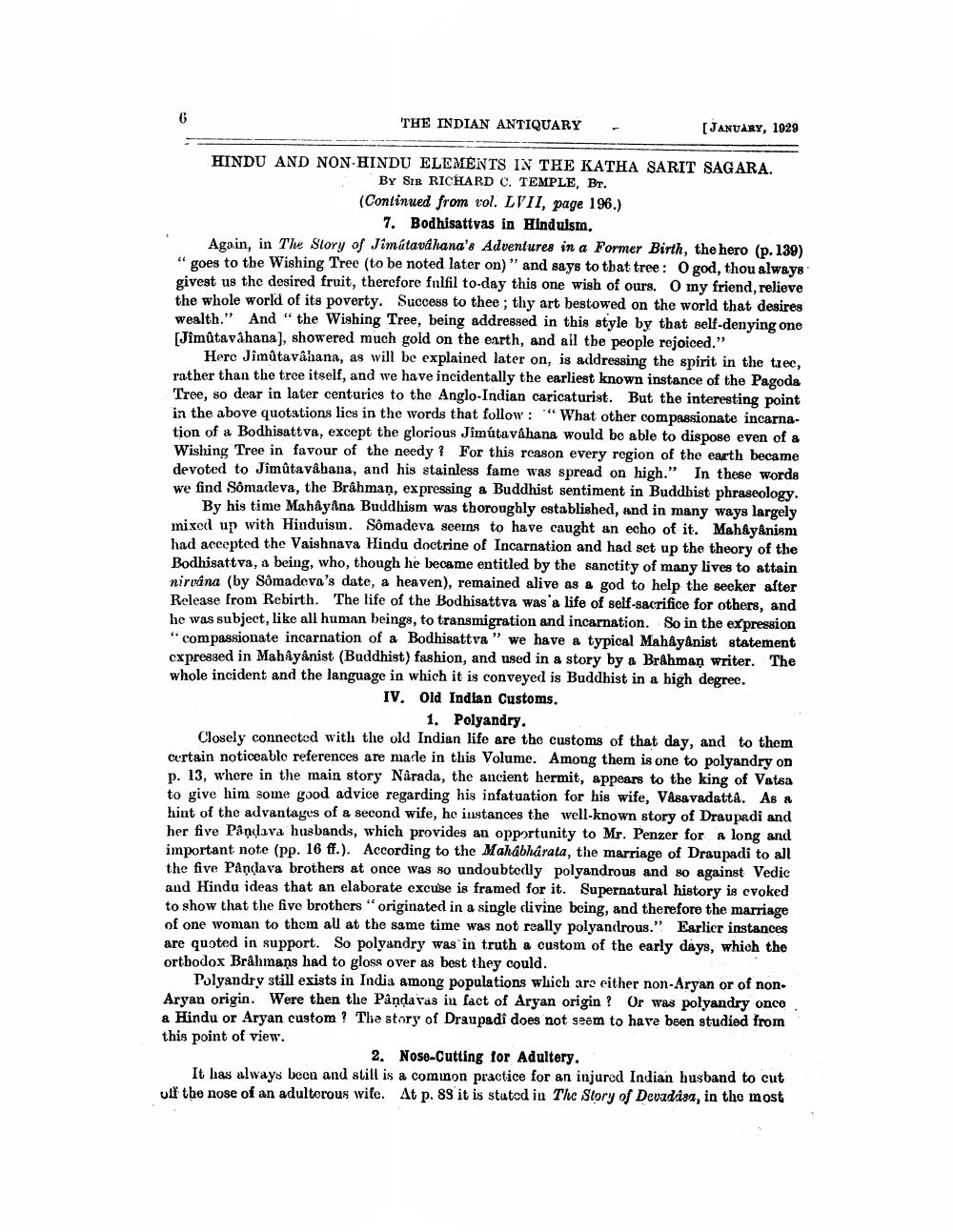________________
6
THE INDIAN ANTIQUARY
[ JANUARY, 1929
HINDU AND NON-HINDU ELEMENTS IN THE KATHA SARIT SAGARA. BY SIR RICHARD C. TEMPLE, Br.
(Continued from vol. LVII, page 196.) 7. Bodhisattvas in Hinduism.
Again, in The Story of Jimútaváhana's Adventures in a Former Birth, the hero (p. 139) 'goes to the Wishing Tree (to be noted later on)" and says to that tree: O god, thou always givest us the desired fruit, therefore fulfil to-day this one wish of ours. O my friend, relieve the whole world of its poverty. Success to thee; thy art bestowed on the world that desires wealth." And "the Wishing Tree, being addressed in this style by that self-denying one [Jimûtavahana], showered much gold on the earth, and all the people rejoiced."
Here Jimûtavahana, as will be explained later on, is addressing the spirit in the tree, rather than the tree itself, and we have incidentally the earliest known instance of the Pagoda Tree, so dear in later centuries to the Anglo-Indian caricaturist. But the interesting point in the above quotations lies in the words that follow: "What other compassionate incarnation of a Bodhisattva, except the glorious Jimútavahana would be able to dispose even of a Wishing Tree in favour of the needy? For this reason every region of the earth became devoted to Jimûtavâhana, and his stainless fame was spread on high." In these words we find Sômadeva, the Brahman, expressing a Buddhist sentiment in Buddhist phraseology. By his time Mahayana Buddhism was thoroughly established, and in many ways largely mixed up with Hinduism. Sômadeva seeins to have caught an echo of it. Mahâyânism had accepted the Vaishnava Hindu doctrine of Incarnation and had set up the theory of the Bodhisattva, a being, who, though he became entitled by the sanctity of many lives to attain nirvana (by Somadeva's date, a heaven), remained alive as a god to help the seeker after Release from Rebirth. The life of the Bodhisattva was a life of self-sacrifice for others, and he was subject, like all human beings, to transmigration and incarnation. So in the expression "compassionate incarnation of a Bodhisattva" we have a typical Mahâyânist statement expressed in Mahâyânist (Buddhist) fashion, and used in a story by a Brahman writer. The whole incident and the language in which it is conveyed is Buddhist in a high degree.
IV. Old Indian Customs.
1. Polyandry.
Closely connected with the old Indian life are the customs of that day, and to them certain noticeable references are made in this Volume. Among them is one to polyandry on p. 13, where in the main story Nârada, the ancient hermit, appears to the king of Vatsa to give him some good advice regarding his infatuation for his wife, Vasavadatta. As a hint of the advantages of a second wife, he instances the well-known story of Draupadi and her five Pândava husbands, which provides an opportunity to Mr. Penzer for a long and important note (pp. 16 ff.). According to the Mahabharata, the marriage of Draupadi to all the five Pandava brothers at once was so undoubtedly polyandrous and so against Vedic and Hindu ideas that an elaborate excuse is framed for it. Supernatural history is evoked to show that the five brothers "originated in a single divine being, and therefore the marriage of one woman to them all at the same time was not really polyandrous." Earlier instances are quoted in support. So polyandry was in truth a custom of the early days, which the orthodox Brahmans had to gloss over as best they could.
Polyandry still exists in India among populations which are either non-Aryan or of nonAryan origin. Were then the Pândavas in fact of Aryan origin? Or was polyandry once a Hindu or Aryan custom? The story of Draupadi does not seem to have been studied from this point of view.
2. Nose-Cutting for Adultery.
It has always been and still is a common practice for an injured Indian husband to cut off the nose of an adulterous wife. At p. 88 it is stated in The Story of Devadása, in the most




